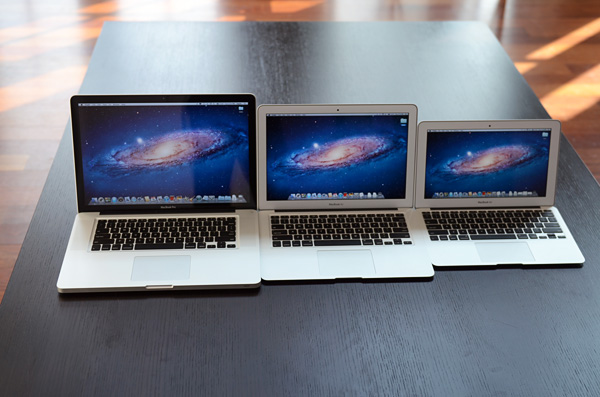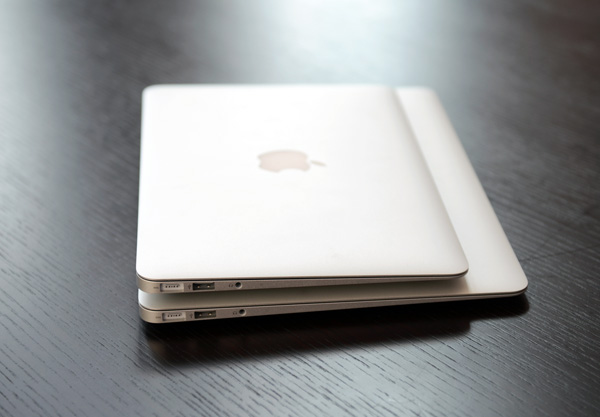The 2011 MacBook Air (11 & 13-inch): Thoroughly Reviewed
by Anand Lal Shimpi on July 28, 2011 3:25 AM EST- Posted in
- Apple
- Mac
- Intel
- Sandy Bridge
- MacBook Air
- Laptops
Final Words
Whereas last year's MacBook Air was a good machine for light work, the 2011 models are true replacements for mainstream portable Macs. There's still no dethroning the MacBook Pro (although the 13-inch model clearly needs a higher resolution display option), but for the rest of the world there are now some excellent ultra portable options that don't force you to really compromise on performance.
Both the 11 and 13-inch MacBook Air are fast enough to replace your 3 year old MacBook Pro and still deliver better performance. You can even move from a 2010 MacBook Pro to an upgraded MacBook Air and not notice any drop in performance. All of this is thanks to Intel's Sandy Bridge CPU.

From left to right: 15-inch MacBook Pro, 13-inch MacBook Air, 11-inch MacBook Air
It's the GPU performance that I'm less excited about. While last year's GeForce 320M isn't significantly faster than the HD 3000 in the new MacBook Air, it's still faster in our tests. There's not much Apple could've done about this. I don't believe a discrete GPU in an Air makes sense, but this should be a clear message to Intel. Sandy Bridge's GPU is the bare minimum, we need to really see a real ramp in performance from here on out. Ivy Bridge will give us a bit of that but not another doubling in GPU performance. Perhaps we'll see something significant from Haswell in 2013. For now, if you like gaming on the go you'll have to get a MacBook Pro.
When it comes to battery life the new MacBook Air doesn't break any records, but it doesn't disappoint either (at least under OS X). With the exception of the our light web browsing test, the new MacBook Air behaves pretty similarly to last year's model on battery power. The new 13 doesn't do anywhere near as well in mostly idle scenarios but under moderate to heavy load the new MBAs last at least as long as their predecessors.
The only move I would be careful about is a downgrade from a 13-inch 2011 MacBook Pro. The new 13-inch MBP is still considerably faster than the MacBook Air, while the more portable form factor is tempting you're better off waiting to see what Apple does with the next update to the MacBook Pro.
If you were a fan of the original MacBook Air, the 2011 models are just as significant of an introduction as the very first one in 2008. They may not look any different from the outside, but the new 11 and 13-inch MacBook Air are a significant step forward. These systems are no longer niche ultraportables, they've instead brought the ultraportable niche into the mainstream.
If you're stuck deciding between the two I think it breaks down like this. If you've got a beefy system at home and just need something portable for travel, the 11-inch Air is perfect. It's now fast enough to get real work done on the road and portable enough to feel like a tablet with an integrated keyboard. If you're replacing a primary notebook however, the 13 is the safer bet. It is sized like a normal notebook, you get longer battery life and a bigger screen to look at. If you're a fan of extremes, the 11 is for you. If you like balanced compromises, go with the 13.
What happens from here on out is what's really interesting. Intel has already committed to moving the TDP of its mainstream parts from 35W - 45W down to 10 - 20W. Since the Air is the new mainstream Mac notebook, Apple has already made that move. The performance in this 10 - 20W segment is going to get much better over the next two years, particularly once Haswell arrives.
The Thunderbolt Display is the first sign of what's to come. Moving IO controllers and expansion into the display, and potentially even moving discrete GPUs out of the notebook are all in store for us. Apple is really ahead of the curve here, but it's easy to imagine a future where laptops become a lot more like the new Air and shift to a couple high bandwidth ports instead of numerous lower bandwidth connections.
There's a lot to like with the new MacBook Airs; the last update was good, but performance was still often lacking. The MBA 11 in particular is now much more useful, and the 13 rightfully spells the end of the line for the old MacBook. While pricing is higher than typical 11" to 13" Windows laptops, you really can't find a competing Windows laptop with all the features the MBA offers without paying a similar price premium. You get a nice chassis with excellent build quality, decent displays that trump every budget laptop we've looked at, and reasonable battery life. If you like thin and light ultraportables, the MacBook Air continues to be one of the best options around.











103 Comments
View All Comments
djpavcy - Thursday, July 28, 2011 - link
In your "2011 MacBook Air Lineup" table the "Cores/Threads" and "Base Clock Speed" categories are messed up.Excellent review btw
apinkel - Thursday, July 28, 2011 - link
Thanks for the review. I am very interested in the 13" MBA as it's the only ultraportable I can find that has what I consider to be the ideal resolution for a laptop display with good performance and battery life (the thinkpad x301 is a close second but there's too much of a performance sacrifce there although I prefer the ports and features on the x301).I need a windows machine... I'm just trying to find out if the MBA is a good windows only machine. I hear conflicting reports on this... I'm sure you guys are busy but if you find the time I'd love to hear your thoughts on using a MBA as windows only.
setzer - Thursday, July 28, 2011 - link
Hi Anand, you have a small typo on the specifications table:Base Clock Speed Intel HD 3000
check - Thursday, July 28, 2011 - link
From Page 4:http://www.anandtech.com/show/4528/the-2011-macboo...
"Apple has sold a USB 10/100 Ethernet dongle in the past for MacBook Air owners, but these days you can get better performance over good WiFi than you can from 100Mbps Ethernet"
I would like to see some testing that substantiates this claim.
In my experience traditional 802.11a/b/g/n can't sustain speeds anywhere near what a 100Mbit wired connection can do. Not to mention that if you are running WPA or any other encryption you take a substantial bandwidth hit.
JarredWalton - Thursday, July 28, 2011 - link
With a good router and WiFi card, and if you're in relatively close proximity to the router, 802.11n can definitely outperform 100Mbit Ethernet. If you're on the other side of the house, it will be slower, but then you'd have to run a 150 foot Ethernet cable. Now, Gigabit Ethernet is in a league of its own compared to WiFi, but we already knew that.Penti - Wednesday, August 10, 2011 - link
Just attach a 10GbE adapter to it then :) Thunderbolt does suppport this kind of expansion.Uritziel - Thursday, July 28, 2011 - link
It's not really necessary to substantiate a claim that an up-to-450Mbps standard "can get better performance" over a 100Mbps standard :\Silenus - Thursday, July 28, 2011 - link
Did you read the the rest of the review? This WAS tested. See the SSD and WiFi performance section:http://www.anandtech.com/show/4528/the-2011-macboo...
Both the 11 and 13 topped 116Mb transfers. 15 Macbook Pro and recent iMac did even better.
lyeoh - Thursday, July 28, 2011 - link
1) That's peak speed.2) That's probably for only one WiFi user with a good zero interference connection to the AP. Add another WiFi user (or ten ;) ) and the speed will drop.
Some (not all) APs also slow down everyone if a WiFi B/G user connects.
A5 - Thursday, July 28, 2011 - link
You're also not going to hit line speed on 100 Mbps networks without an optimal set of conditions. For everyday use (even with multiple users, etc), 802.11n is good enough and far easier to install a new network than 100 Mbps wired Ethernet.If you're doing a lot of the large file transfers or movie streaming, consider installing a Gigabit network though.